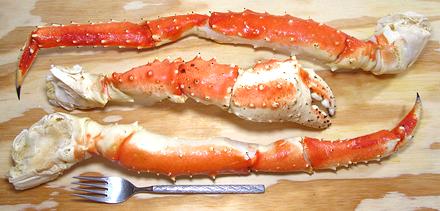 [Red King Crab, Paralithodes camtschaticus |
Blue King Crab, Paralithodes platypus |
Golden King Crab, Brown King Crab, Lithodes aequispinus]
[Red King Crab, Paralithodes camtschaticus |
Blue King Crab, Paralithodes platypus |
Golden King Crab, Brown King Crab, Lithodes aequispinus]
King crabs are not actually crabs but belong to another family of Decapods, the Lithodidae. They are thought by to have evolved from hermit crabs (also not true crabs). Because of their size and spindly shape they are cooked immediately upon capture and broken into legs and claw arms which are shipped (generally frozen) to markets.
The three crabs listed in the title are all from Alaska, the Blue King being the largest, the Red King second largest and the Golden King considerably smaller (thus lower in price). All three are marketed as "Alaskan King Crab" and all are pretty much the same red color when cooked so you can't tell them apart in the market. The legs and claws in the photo were from Russia. The larger of the legs was 18 inches long and weighed 14 ounces. The claw was 9.8 inches long and weighed 12.5 ounces. Blue King legs can be over 28 inches long.
This crab is difficult to catch and is not considered endangered. It was introduced to the Barents sea off Russia in the 1960s and the population there has exploded and spread as far away as Norway to the dismay of ecologists and many fishermen and the delight of others who enjoy the high price they fetch.
More on Crabs.
The ideal tools for eating King Crab legs and claws are a pair of kitchen shears and a pair of chopsticks. A chopstick can be used to push crabmeat out of tubular leg parts and the pair can be used for dipping small pieces or crab in whatever sauce you may be using.
Yield: You'll be buying arms and legs and steaming them lightly to reheat so the yield is better than for whole crabs - most of the weight loss has already happened. A 16-1/2 inch 2.8 oz leg with body portion attached yielded 1.5 oz of crabmeat (54%) and a 9 inch 5.2 oz claw yielded 2.3 oz of crabmeat (44%) so with an average mix you'll probably get around 50%.
sf_cbkingz 060925 - www.clovegarden.com